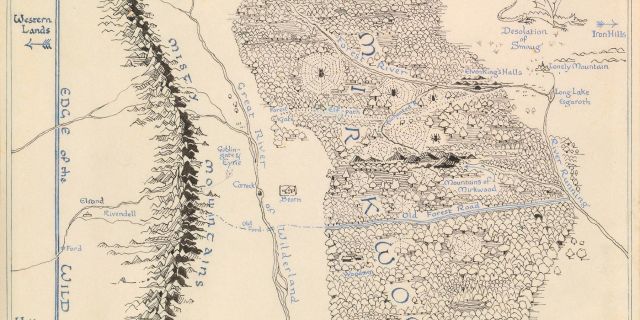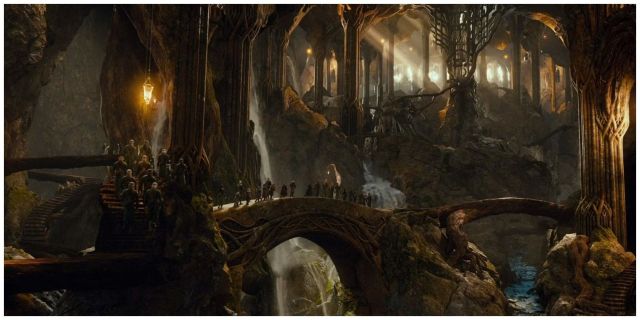Quick Links
-
Early Days
-
Greenwood the Great
-
The Downfall of Greenwood
Of the many wonders in Middle-Earth, few are more imposing and mysterious than the great forest of Mirkwood. Fans of Tolkien’s work will undoubtedly remember the Company of Thorin’s perilous journey through the dark woods, as told in both the original Hobbit novel and Peter Jackson’s film trilogy. Unlike what is shown in The Hobbit, however, Mirkwood wasn’t always shrouded in darkness, as it was once the most beautiful forest in all of Middle-Earth.
In both The Hobbit and The Lord of the Rings, Mirkwood is home to the reclusive Wood-Elves, of which Legolas is a member. While these Elves maintain their home in the woods, their realm has slowly deteriorated and succumbed to the darkness of evil forces. Chief among these is the threat of a terrible sorcerer known only as “the Necromancer,” whose true motives prove to be far more sinister than even the Elves are aware of. In the early days of Middle-Earth’s history, however, Mirkwood was called Greenwood, and its trees were a sanctuary for the Elves and their kingdom. What exactly happened to Mirkwood, and what was it like before it was corrupted by evil?
Early Days

From the very beginning of Middle-Earth, Greenwood existed as the largest forest on the entire continent. Its borders covered a huge portion of the region known as Rhovanion (or Wilderland), and contained a small mountain range as well as a river. As told in The Silmarillion, the historical account of Middle-Earth’s earliest days, the Elves awoke in the east of Middle-Earth and soon began a long migration to the Far West. During this journey, they first traveled through Greenwood, and it was here that a great many of the Elves elected to stay.
The Elves that remained in Greenwood were of the Nandor, a Quenya word which means “those who turn back.” As these Elves continued to live in the great forest and spread to other areas in the region (such as what would one day become Lothlórien), they became known as the Silvan: Wood-Elves. For the entire First Age of Middle-Earth, during which Sauron’s master, Morgoth, terrorized the western realm of Beleriand, the Silvan of Greenwood remained relatively unaffected. In those early days, they enjoyed the beautiful peace of the forest, forging powerful connections with the plants and animals that lived within.
At the end of the First Age, after the fall of Beleriand, many of the Elves who dwelt in that land migrated east. Of these was an Elf named Oropher, one of the Sindar, who came to Greenwood in the early years of the Second Age. Oropher was welcomed by the Silvan of the great forest, and eventually became the King of their people. Here, he officially established the Woodland Realm, an Elven kingdom that would remain in Middle-Earth for the rest of the Elves’ time in Middle-Earth.
Greenwood the Great

Under the rule of Oropher and the protection of his new Woodland Realm, Greenwood flourished. The kingdom’s capital was built in the south of the forest, on the hill of Amon Lanc. Soon, Greenwood was the primary settlement for Elves within Middle-Earth. This was the golden age of the kingdom, and it was in those early years of the Second Age that both Men and Elves revered Greenwood as one of the most beautiful places in Middle-Earth. The Elves were even democratic with the nearby Dwarves of Erebor, allowing them to create the Old Forest Road that cut through Greenwood just south of its mountains.
For the majority of the Second Age, Greenwood and its Elven kingdom lived in peace. During this time, however, Sauron rose to power as the second Dark Lord. With such ill tidings brewing in Middle-Earth, Oropher and his people abandoned Amon Lanc and took up new dwellings in the Mountains of Mirkwood. While the Silvan had always remained relatively uninvolved in the great wars of their world, the evil of Sauron grew too powerful to ignore. In SA 3429, Oropher and his army joined the War of the Last Alliance, marching against the Black Gates of Mordor in a powerful show of defiance. While Sauron was eventually defeated, the long battle would see Oropher slain, and the title of King of the Woodland Realm passed to his son, Thranduil.
Roughly one thousand years into the rule of King Thranduil, the spirit of Sauron returned to Middle-Earth in the form of the Necromancer. Upon his return, he chose the abandoned fortress atop Amon Lanc in which to plot his resurgence. Under the shadow of Sauron’s dark power, the once great Elven stronghold soon became something more sinister: Dol Guldur, the domain of the Necromancer. Thandruil and the Elves were quite aware that their former homeland had been captured, but they did not yet fear the Necromancer’s power or suspect his true identity.
The Downfall of Greenwood
With the arrival of Sauron, the sancity of Greenwood was suddenly under attack. The forest soon became haunted by packs of wandering Orcs, as well as massive spiders which clogged the boughs with their webs. The Forest River became so polluted with foul debris that its waters caused overwhelming fatigue to anyone who encountered them. The Wood-Elves did their best to repel these dark forces, but eventually Thranduil was forced to lead his people further north, close to the Lonely Mountain. Here, they built a new stronghold that consisted of caves and tunnels, a location that would in fact be visited by Bilbo and the Dwarves during the events of The Hobbit.
As the darkness in Greenwood grew, the outside world soon became quite wary of the great forest. What had once been a shining example of Middle-Earth’s natural beauty was now a labyrinthine death-trap infested with monsters. Soon, the name Greenwood was all but forgotten, and the forest was instead known by the far more sinister title of Mirkwood.
As the Third Age continued, the Woodland Realm became more and more secluded in an effort to maintain its safety. Unfortunately, this meant that the dark forces within the forest were able to grow relatively unchecked. Even with the departure of Sauron from Dol Guldur in TA 2063, his influence continued to fester within the woods. By the time of The Lord of the Rings and The Hobbit, Mirkwood is practically impassable, only navigable by a single “Elf-Road” that allowed passage to Erebor. Fortunately, with the defeat of Sauron at the end of The Lord of the Rings and the destruction of the One Ring, the evil within Mirkwood was gradually stamped out. While the Elves themselves were not long to remain in Middle-Earth, Mirkwood soon returned to a glimpse of its former beauty, now habitable by Men and fair creatures for the first time in thousands of years.











Leave a Reply